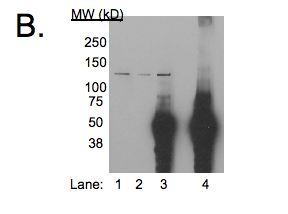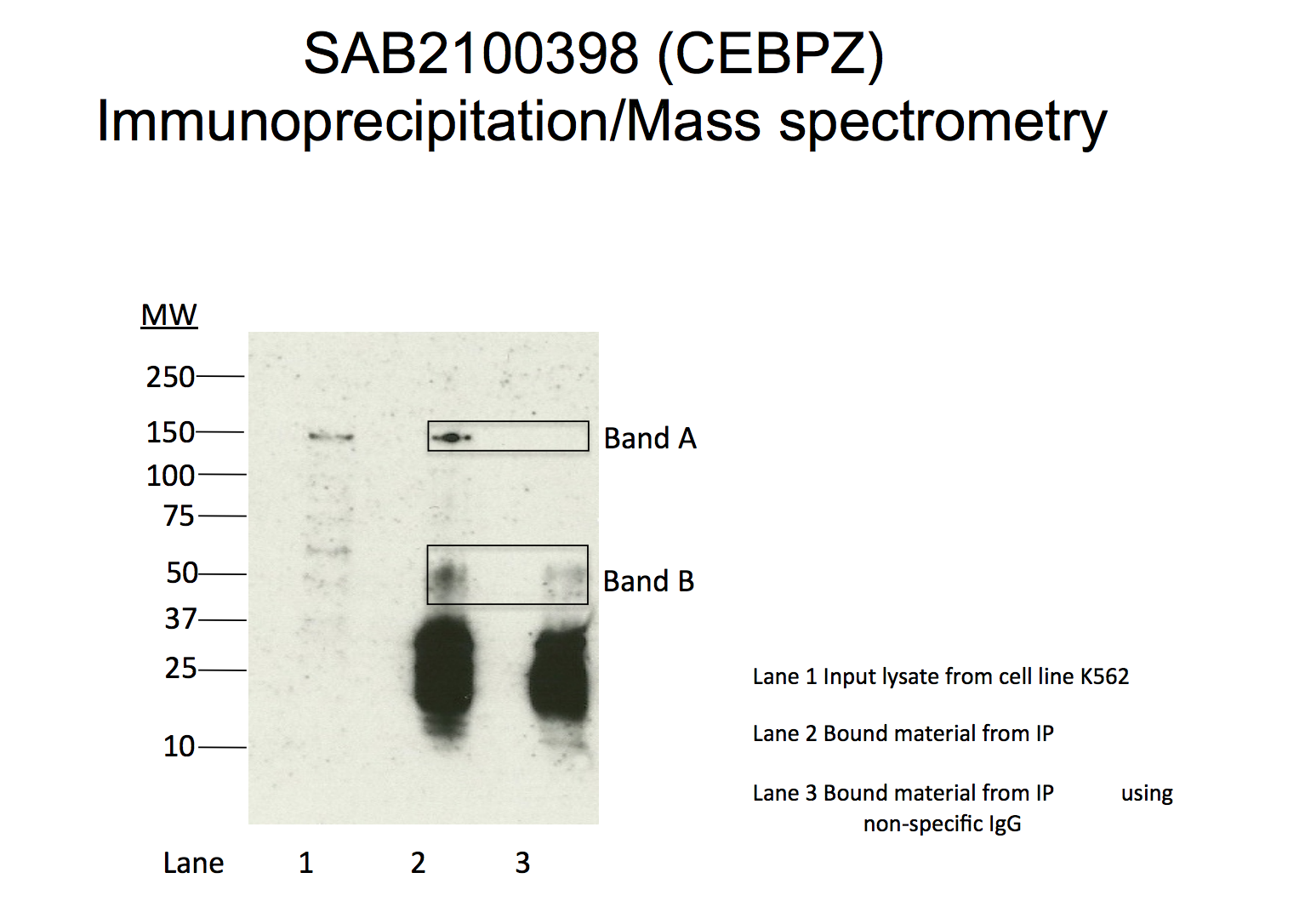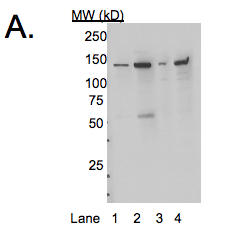ENCAB000ADO
Antibody against Homo sapiens CEBPZ
Homo sapiens
K562, GM12878, HeLa-S3, HepG2
characterized to standards
Homo sapiens
any cell type or tissue, HEK293T
partially characterized
- Status
- released
- Source (vendor)
- Sigma
- Product ID
- SAB2100398
- Lot ID
- QC8343
- Characterized targets
- CEBPZ (Homo sapiens)
- Host
- rabbit
- Clonality
- polyclonal
- Purification
- affinity
- Antigen description
- Peptide region of the protein sequence according to NP_005751.
- Antigen sequence
- KDNASLKQLRWEAERDDWLHNRDAKSIIKKKKHFKKKRIKTTQKTKKQRK
- External resources
Characterizations
CEBPZ (Homo sapiens)
Method: immunoprecipitation followed by mass spectrometry
compliant
- Caption
- IP followed by mass spectrometry: Briefly, K562 whole cell lysates were immunoprecipitated using SAB2100398, and the IP fraction was loaded on a 10% polyacrylamide gel (NuPAGE Bis-Tris Gel) and separated with an invitrogen NuPAGE electrophoresis system. The gel was silver-stained, gel fragments corresponding to the bands indicated were excised and destained using the SilverSNAP Stain for Mass Spectrometry (Pierce). Then proteins were trysinized using the in-gel digestion method. Digested proteins were analyzed on an LTQ-Orbitrap (Thermo Scientific) by the nanoLC-ESI-MS/MS technique. Peptides were identified by the SEQUEST algorithm and filtered with a high confidence threshold (Protein false discovery rate < 1%, 2 peptides per protein minimum). We report only 4 proteins identified in band A, where the majority of signal detected by Western blot is located. CEBPZ is the most abundant of these (14 peptides) and is the only predicted sequence-specific DNA-binding protein. We also note that CEBPZ is found in the control immunoprecipitation, but CEBPZ is known to be abundant and is present at much higher levels in the specific immunoprecipitation relative to the control (3.5 fold enrichment; in comparison the other two proteins identified in this band from both samples are 4-13 fold enriched in the control immunoprecipitation). We also tested a lower band which contained a minor fraction of the signal seen in the Western blots. We identify 89 proteins in band B and CEBPZ was the third most abundant of these (15 peptides) and the most abundant protein highly enriched in the specific immunoprecipitation. Based on these observations, all major bands are likely due to the presence of immunoprecipated CEBPZ and SAB2100398 meets the ENCODE standard for validation by this criterion.
- Submitted by
- Kathrina Onate
- Lab
- Michael Snyder, Stanford
- Grant
- U54HG004558
- Download
- CEBPZ_final_ADO.pdf
CEBPZ (Homo sapiens)
HEK293T
not submitted for review by lab
- Caption
- Immunoprecipitation was performed on nuclear extracts from the cell line: HEK293T using the antibody SAB2100398. The image shows western blot analysis of input, flowthrough, immunoprecipitate, and mock immunoprecipitate using IgG. Target molecular weight: 130.0.
- Submitted by
- Nathaniel Watson
- Lab
- Michael Snyder, Stanford
- Grant
- U54HG006996
- Download
- Expt1038_83-CEBPZ-SAB2100398.JPG
CEBPZ (Homo sapiens)
Method: immunoprecipitation
not reviewed
- Caption
- We observe one major band consistent with the expected size of CEBPZ (121kD) in cell lines GM12878, K562, HeLa S3, and HepG2. This band is specifically immunoprecipitated with moderate efficiency (note presence of some material in unbound fration (lane 2)) from K562 cells, with no other bands visibly immunoprecipitated. Additionally, we performed mass spectrometry analysis on both bands immunoprecipitated from K562 and identified Maz as a major component of each band (see validation #2). Therefore, SAB2100398 meets this criterion for validation.
- Submitted by
- Michael Snyder
- Lab
- Michael Snyder, Stanford
- Grant
- U54HG004558
- Download
- human_CEBPZ_validation_Snyder.pdf
CEBPZ (Homo sapiens)
Method: immunoprecipitation followed by mass spectrometry
not reviewed
- Caption
- Immunoprecipitation of CEBPZ from K562 cells using SAB2100398. Lane 1: input nuclear lysate, Lane 2: material immunoprecipitated with ab87525, Lane 3: material immunoprecipitated using control IgG. Bands A and B were excised from the gel and subject to analysis by mass spectrometry. IP followed by mass spectrometry: Briefly, K562 whole cell lysates were immunoprecipitated using SAB2100398, and the IP fraction was loaded on a 10% polyacrylamide gel (NuPAGE Bis-Tris Gel) and separated with an invitrogen NuPAGE electrophoresis system. The gel was silver-stained, gel fragments corresponding to the bands indicated were excised and destained using the SilverSNAP Stain for Mass Spectrometry (Pierce). Then proteins were trypsinized using the in-gel digestion method. Digested proteins were analyzed on an LTQ-Orbitrap (Thermo Scientific) by the nanoLC-ESI-MS/MS technique. Peptides were identified by the SEQUEST algorithm and filtered with a high confidence threshold (Protein false discovery rate < 1%, 2 peptides per protein minimum). We report only 4 proteins identified in band A, where the majority of signal detected by Western blot is located. CEBPZ is the most abundant of these (14 peptides) and is the only predicted sequence-specific DNA-binding protein. We also note that CEBPZ is found in the control immunoprecipitation, but CEBPZ is known to be abundant and is present at much higher levels in the specific immunoprecipitation relative to the control (3.5 fold enrichment; in comparison the other two proteins identified in this band from both samples are 4-13 fold enriched in the control immunoprecipitation). We also tested a lower band which contained a minor fraction of the signal seen in the Western blots. We identify 89 proteins in band B and CEBPZ was the third most abundant of these (15 peptides) and the most abundant protein highly enriched in the specific immunoprecipitation. Based on these observations, all major bands are likely due to the presence of immunoprecipated CEBPZ and SAB2100398 meets the ENCODE standard for validation by this criterion.
- Submitted by
- Michael Snyder
- Lab
- Michael Snyder, Stanford
- Grant
- U54HG004558
- Download
- human_CEBPZ_validation_Snyder.pdf
CEBPZ (Homo sapiens)
K562
compliant
- Caption
- B. Immunoprecipitation of CEBPZ from K562 cells using SAB2100398. Lane 1: input nuclear lysate, Lane 2: unbound material from immunoprecipitation with ab87525, Lane 3: material immunoprecipitated with ab9263, Lane 4: material immunoprecipitated using control IgG. Expected band size of CEBPZ in all cell lines included is 121 kD.
- Submitted by
- Kathrina Onate
- Lab
- Michael Snyder, Stanford
- Grant
- U54HG004558
- Download
- IP Snyder ADO.png
CEBPZ (Homo sapiens)
K562
compliant
- Caption
- Immunoprecipitation of CEBPZ fromK562 cells using SAB2100398. Lane 1: input nuclear lysate. Lane 2: material immunoprecipitated with ab87525. Lane 3: material immunoprecipitated using control IgG. Bands A and B were excised from gel and subject to analysis by mass spectrometry.
- Submitted by
- Kathrina Onate
- Lab
- Michael Snyder, Stanford
- Grant
- U54HG004558
- Download
- IP-MS_K562 Snyder ADO.png
CEBPZ (Homo sapiens)
GM12878K562HeLa-S3HepG2
compliant
- Caption
- A. Western blot using SAB2100398. Lanes contain nuclear lysates from GM12878 cells (Lane 1), K562 cells (Lane 2), HeLa-s3 cells (Lane 3), and HepG2 cells (Lane 4). Expected band size of CEBPZ in all cell lines included is 121 kD.
- Submitted by
- Kathrina Onate
- Lab
- Michael Snyder, Stanford
- Grant
- U54HG004558
- Download
- WB Snyder ADO.png


